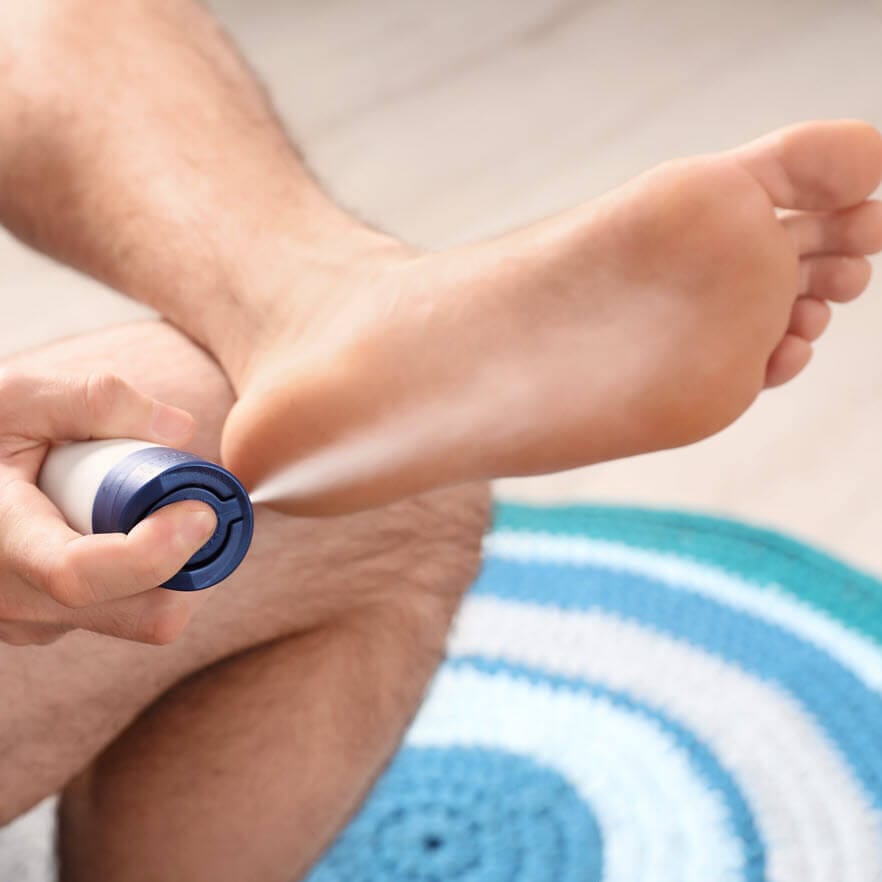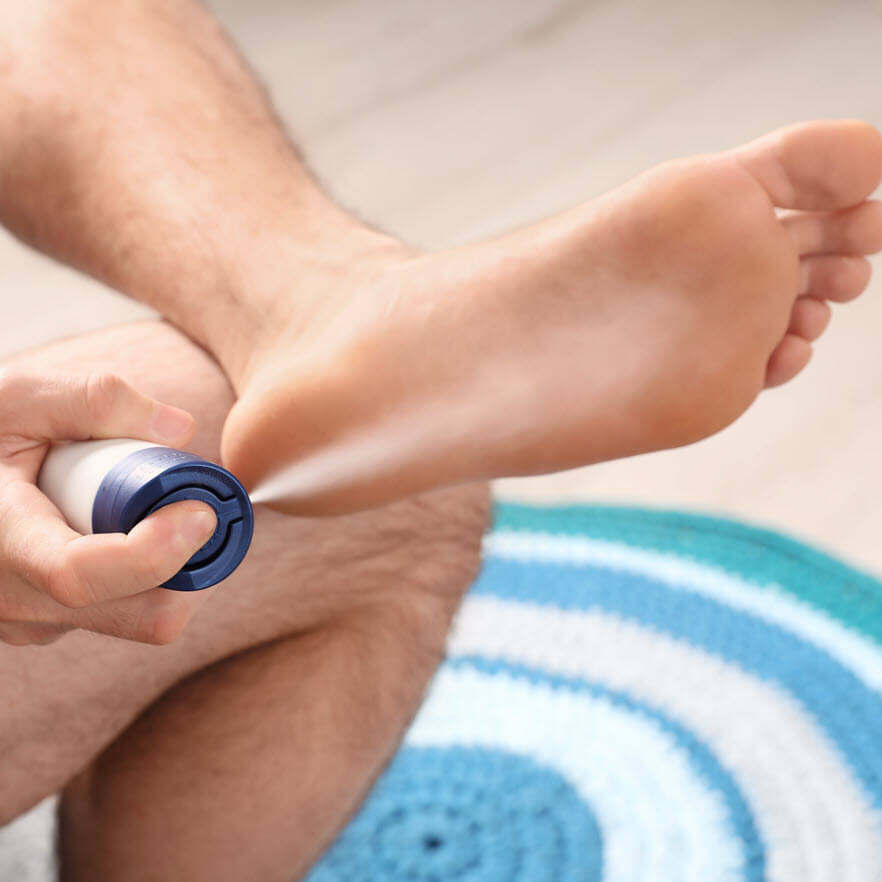Got a favourite under-arm you spray on your feet before you head out? You know, to stop your feet from sweating so much, to stop blisters. Does it work? In this article, we'll look at the research to see if antiperspirants prevent blisters?

How Might Antiperspirants Prevent Blisters?
Skin hydration is known to increase skin friction and the likelihood of blisters.1-13 Physiologically, moisture on the skin surface comes from perspiration. As a result, antiperspirants have an intuitive effect on blister incidence. However, in spite of a significant amount of research performed, mostly in military settings, antiperspirants have been found to be ineffective in preventing foot blisters. Here's the research to date.
Study 1: Darrigrand et al
- Subjects: 19 male soldiers were treated with one of two antiperspirants for 5 days before participating in a 1-hour treadmill march in warm conditions. This was repeated several months later using the other antiperspirant. Each experimental phase lasted 7consecutive days with the first 2 days serving as control days. 16 subjects successfully completed all testing.
- Interventions:
- (a) Antiperspirant 1 - aluminium chlorohydrate
- (b) Antiperspirant 2 - aluminum zirconium tetrachlorohydrex glycine
- (c) No intervention
- Results:
- Antiperspirant 1 (aluminum chlorohydrate):
- Blister incidence: 0% for antiperspirant group vs 50% (8 of 16 subjects) for control group. Strangely, this was erroneously reported as non-statistically significant by the authors, but is in fact statistically significant according to their own calculation and discussion by Knapik in 1998.
- Irritant dermatitis: 43.75% for antiperspirant group vs 0% for control group (p<0.05)
- Antiperspirant 2 (aluminum zirconium tetrachlorohydrex glycine):
- 18.75% (3 of 16 subjects) for antiperspirant group vs 50% (8 of 16 subjects) for control group (not statistically significant)
- Irritant dermatitis: 31.25% for antiperspirant group vs 0% for control group (p<0.05)
- Conclusion: The positive outcome of aluminium chlorohydrate antiperspirant on blister incidence was offset by an increased incidence of irritant dermatitis.
Study 2: Knapik et al
- Subjects: 667 military cadets applied a preparation to their feet for 5 nights preceding a 21km hike
- Interventions:
- (a) 328 subjects used an antiperspirant - 20% aluminum chloride hexahydrate in anhydrous ethyl alcohol
- (b) 339 subjects used the placebo - anhydrous ethyl alcohol
- Results:
- Blister incidence: 21% for the antiperspirant group and 48% for the placebo group (p<0.01)
- Skin irritation: 57% for the antiperspirant group and 6% for the placebo group (p< 0.01)
- Notes: It was not stated if groups were randomised and there was a high rate of noncompliance with the treatment schedule
- Conclusion: Similar to the previous study, the positive outcome of aluminium chlorohydrate antiperspirant on blister incidence was offset by an increased incidence of irritant dermatitis.
Study 3: Reynolds et al
- Subjects: 23 healthy men walking on a treadmill in a warm environment wearing standard military apparel and equipment, totalling 21kg. Subjects were treated with the test topical applications each morning for the 4 days before the treadmill walk.
- Interventions:
- (a) Antiperspirant (20% aluminum zirconium tetrachlorohydrex glycine concentration plus water) with emollient additives
- (b) Emollient additives alone (placebo)
- (c) Nothing (nontreated)
- Results:
- Blister incidence: 39% for the antiperspirant group and 52% for the placebo group (which was not statistically significant)
- Skin irritation: No skin irritation in any groups
- Further: No differences were seen among treatment conditions for sweat accumulation (p = 0.86), blister incidence (p = 0.36), hot spot incidence (p = 0.83), or blister severity (p = 0.31).
- Conclusion: While irritant dermatitis was eliminated with the emollient additives to the antiperspirant, blister protection was lost with blister incidence similar among all groups.
The table on this page summarises the results of the three studies nicely.
Study 4: Hashmi et al
- Subjects: 30 healthy individuals, randomised into 3 treatment groups, with an intermittent shear load applied to the back of the heel while skin hydration and temperature changes were measured.
- Interventions: 10 subjects had Boots Antiperspirant Foot Spray sprayed onto the skin, allowed to dry before testing.
- Results: No change in foot skin hydration or rate of temperature change between the three treatment groups or compared to baseline measures.
- Conclusion: The antiperspirant did not affect foot skin hydration or rate of temperature change thought to be predictive on imminent blister formation.
Wrapping up
It's fair to say, antiperspirants do not prevent blisters.
- Read this article to find out how to keep your feet dry on a hot day.
- Read this article to learn more about managing excessively sweaty feet
References
- Naylor PFD. Experimental friction blisters. Br J Dermatol. 1955;67(10):327-342. doi:10.1111/j.1365-2133.1955.tb12657.x
- Sulzberger MB, Cortese TA, Fishman L, Wiley HS. Studies on blisters produced by friction I - Results of linear rubbing and twisting technics. J Invest Dermatol. 1966;47(5):456-465.
- Naylor PFD. The skin surface and friction. Br J Dermatol. 1955;67(7):239-248. doi:10.1111/j.1365-2133.1955.tb12729.x
- Hashmi F. Friction Foot Blisters: The Effect of Hydration on the Risk of Blister Creation. In: Agache’s Measuring the Skin. Springer, Cham; 2015:1487-1494. doi:10.1007/978-3-319-26594-0_145-1
- Knapik JJ, Hamlet MP, Thompson KJ, Jones BH. Influence of boot-sock systems on frequency and severity of foot blisters. Mil Med. 1996;161(10):594-598. doi:10.1093/milmed/161.10.594
- William A Akers. Sulzberger On Friction Blistering. Int J Dermatol. 1977;16(June):369-372.
- El-Shimi AF. In vivo skin friction measurements. J Soc Cosmet Chem. 1977;(28):37-51.
- Highly D, Coomey M, DenBeste M, Wolfram L. Frictional Properties of Skin.pdf. J Invest Dermatol. 1977;69(3):303-305.
- Kirkham S, Lam S, Nester C, Hashmi F. The effect of hydration on the risk of friction blister formation on the heel of the foot. Ski Res Technol. 2014;20(2):246-253. doi:10.1111/srt.12136
- Veijgen NK, Masen MA, Van Der Heide E. Relating friction on the human skin to the hydration and temperature of the skin. Tribol Lett. 2013;49(1):251-262. doi:10.1007/s11249-012-0062-1
- Darrigrand A, Reynolds K, Jackson R, Hamlet M, Roberts D. Efficacy of antiperspirants on feet. Mil Med. 1992;157(5):256-259.
- Reynolds K, Darrigrand A, Roberts D, et al. Effects of an antiperspirant with emollients on foot-sweat accumulation and blister formation while walking in the heat. J Am Acad Dermatol. 1995;33(4):626-630.
- Hashmi F, Kirkham S, Nester C, Lam S. The effect of topical anti blister products on the risk of friction blister formation on the foot. J Tissue Viability. 2016;25(3):167-174. doi:10.1016/j.jtv.2016.04.002
ENGO Blister Patches Reduce Friction Levels Better Than Antiperspirants
Excessively sweaty feet means any blister product applied to your skin is likely to be less effective. The moisture will make it come unstuck, dissolve it or help it disperse away from where you actually need it. Instead, use ENGO Blister Patches that apply to your shoe, not your skin. Friction measurements have shown that no matter how sweaty your feet get, ENGO Blister Patches keep friction levels low. Their adhesion is unaffected by perspiration.








